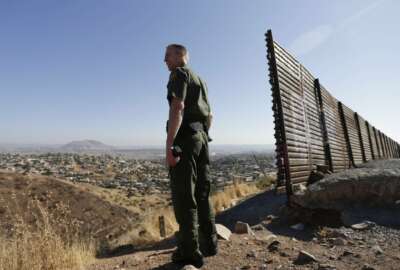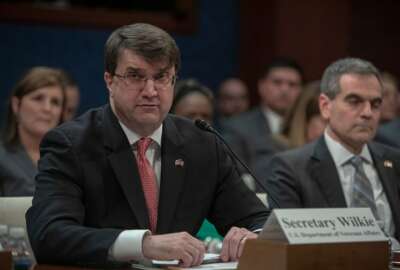

The Department of Homeland Security three years ago didn't know how many employees it had working on a given mission at a particular time, nor did it know how m...
Ask a civilian agency how many people it has working on a particular mission and its top leadership may or may not be able to answer.
Veterans Affairs Secretary Robert Wilkie said he realized just how vexing that question was when he asked his leadership staff for specific workforce numbers when he first arrived at VA from the Pentagon. He received two different numbers from two senior VA officials about the number of employees at the department.
But many civilian agencies don’t have the equivalent of a “manning document” — or a list of their requirements and the people who meet them, said Sidney Evans, assistant director of program analysis and evaluation for manpower and organization at the Department of Homeland Security.
“When you go to non-DoD agencies you’ll find there’s a little confusion about the concept of manpower,” Evans said last month at the Association of Government Accountants’ National Leadership Training summit in Washington. “The way we characterize it is, it’s spaces, not faces. In other words, [it’s] a way to tie our human capital requirements to the organizational strategy and then to tie it to missions… and [to] the financial community, so you can see what the total suite of resources are that are associated with our programs both today and into the future.”
Top DHS leadership asked their senior executives back in 2015 to pinpoint how many employees and vacancies the department had. But the answer was difficult to come by, said Evans, who at the time was tasked with answering the question for Customs and Border Protection.
“We had no idea, because we [didn’t have] the discipline to make sure we managed the positions,” he said. “We managed the people. We managed the payroll. We didn’t manage the positions, and we didn’t manage the mission.”
Since then, DHS has been developing a workforce staffing model manual and guidance to help the department’s subcomponents better align its employees with their mission requirements. DHS is also setting policies that describe the standards and desired outcomes of a successful staffing model.
Today, staffing models cover 64 percent of all positions at DHS, Evans said. The number is higher for DHS law enforcement positions, which make up 80 percent of all jobs at the department. Staffing models cover 92 percent of law enforcement positions at agencies such as U.S. Citizenship and Immigration Services, Immigration and Customs Enforcement, CBP, FEMA and the Secret Service.
Still, DHS sees room to grow with its use of staffing models. DHS has 210,000 civilian employees but counts 360,000 total job positions, Evans said.
“If I leave my job, my replacement should be placed in my job and position number,” he said. “[It] sounds simple, but it doesn’t happen so much. We’re trying to instill some discipline for things like that, so people aren’t just people, but people are the tools that we use to accomplish some segment of the mission.”
Individual DHS components have been developing and evolving their own staffing models.
USCIS, for example, has been using a staffing model to track and project how many employees the agency will need to adjudicate applications and process other kinds of forms for more than 10 years.
“We are able to determine how many people are needed in any given year to complete the amount of applications that we are projecting,” said Alecia Davis, chief of USCIS’ workload analysis and resource modeling division. “We know how long it takes a person to actually adjudicate an application. We know how many we intend to get for that entire year, and then we determine how many additional people we will request from the [chief financial officer] to adjudicate those applications.”
But more recently, the agency created staffing models to track and project workforce needs within the USCIS management offices that handle IT, security and finance, Davis said.
USCIS can track more than 90 percent of its workforce now using these models, she said, and they’re getting more sophisticated.
Staffing models have changed how USCIS responds to a new policy from an administration. Davis said the agency can predict how a policy change will alter the time it takes for an adjudicator to process an application. The models can also predict which of USCIS’ five service centers can handle additional work or whether the agency should consider moving workload from one field office to another that has adjudicators with a specific specialization, Davis said.
Staffing models are also helping the Transportation Security Administration cope with the ever-changing nature of its workload.
“Our work requirements change by the half-hour, and it changes by the day,” said Michael Coffman, a TSA program manager. “We don’t need the same number of officers at an airport on a Sunday as on Monday. We have to look at that when we’re doing our staffing allocations and make adjustments for that.”
But beyond simple scheduling for TSA officers, the agency is also updating its staffing models to consider other changes that are beyond its control.
Airports are constantly changing the number of TSA checkpoints and building new terminals, while airlines are adding more seats and packing planes full with more people than before, Coffman said. All of those conditions factor into TSA staffing models and help the agency’s managers determine how many officers specific checkpoints and terminals may need at any given hour.
For TSA and other DHS components, the goal is to transform their staffing models from mere budgeting tools to more operational ones that help the department with its workforce and succession planning.
And with common DHS staffing model standards, Evans also sees an opportunity to standardize human resources across the department.
“There may be good reasons to deviate, but in general, HR at ICE … should look like HR at FEMA or HR at TSA,” Evans said. “They should perform the same functions. They should have very similar ways of doing business, unless there are functional differences in their component with how they operate. We are looking to try to not necessarily force people into boxes on the organizational structure but standardize where standardization makes sense and enable deliberate deviation from the norm.”
Copyright © 2024 Federal News Network. All rights reserved. This website is not intended for users located within the European Economic Area.
Nicole Ogrysko is a reporter for Federal News Network focusing on the federal workforce and federal pay and benefits.
Follow @nogryskoWFED


